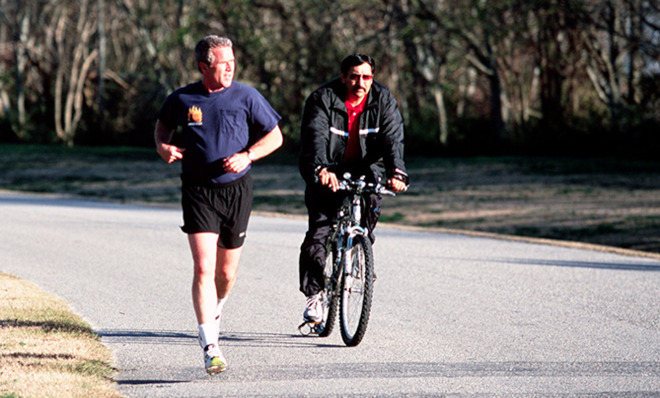Right- and left-wingers are more physically active than centrists
People in the "mushy middle" are more likely to have mushy physiques


In these polarized times, it's always a relief to find something liberals and conservatives have in common — even if it has nothing to do with politics. New research suggests that, at least in Europe, people who lean decisively right or left get considerably more exercise than those in the center.
"Busy people at both ends of the political spectrum do not seem to have as much time for idleness," writes a research team led by Adrian Bauman of the University of Sydney's School of Public Health. In contrast, centrists do more sitting, "both on the fence and elsewhere."
Bauman's study, published in The BMJ (formerly the British Medical Journal), used data from the Eurobarometer, a survey conducted on behalf of the European Commission. Participants (with a mean age of 46) were from 32 European nations; all indicated their political orientation on a scale of one (far left wing) to 10 (far right wing).
The Week
Escape your echo chamber. Get the facts behind the news, plus analysis from multiple perspectives.

Sign up for The Week's Free Newsletters
From our morning news briefing to a weekly Good News Newsletter, get the best of The Week delivered directly to your inbox.
From our morning news briefing to a weekly Good News Newsletter, get the best of The Week delivered directly to your inbox.
The researchers compared responses from three groups of people: Those on the far left (the 6.8 percent who listed themselves as a "1" or "2"); those on the far right ("9" or "10"); and those in the center (the remainder). The two extreme groups were each comprised of around 1,900 people, while more than 17,000 placed themselves in the broad center.
All participants listed their "weekly minutes of vigorous intensity activity, moderate intensity activity, and walking," the researchers note. "These scores were summed to estimate total physical activity." A separate question asked them to estimate "total daily minutes of sitting time."
According to those self-reports, people on both the right and left engaged in a greater amount of total physical activity than those in the middle — approximately one hour more each week. They also enjoyed (or at least endured) larger doses of vigorous activity, clocking in at roughly 30 minutes more per week than centrists.
Those who reported no political affiliation were the most sedentary, spending 40 minutes less time on physical activities per week than those in the center.
A free daily email with the biggest news stories of the day – and the best features from TheWeek.com
Total sitting time did not differ all that much, with leftists and centrists at similar levels. Compared to those groups, right wingers spent an average of 13 minutes less per day on their butts. All of these findings still held true after adjusting for age, sex, education, and country.
"Centrists and the politically uncommitted may be at greater risk of non-communicable diseases because of their inertia," Bauman and his colleagues warn. "The politically uncommitted and centrists could consider adopting a stronger political stance for their health."
That doesn't seem likely to occur, which may be just as well: At this juncture in history, it doesn't seem wise to encourage extremism, even if it could improve people's health.
Still, it's interesting to consider the possibility that there could be a link between the obesity epidemic, and the apathy reflected in recent mid-term election's low turnout rates. If Americans follow the same patterns as Europeans, those in the "mushy middle" are more likely to have mushy physiques.
Pacific Standard grapples with the nation's biggest issues by illuminating why we do what we do. For more on the science of society, sign up for its weekly email update or subscribe to its bimonthly print magazine.
More from Pacific Standard...
-
 How the War Department became the Department of Defense – and back again
How the War Department became the Department of Defense – and back againIn Depth In 1947 President Harry Truman restructured the US military establishment, breaking with naming tradition
-
 Codeword: December 8, 2025
Codeword: December 8, 2025The daily codeword puzzle from The Week
-
 Sudoku medium: December 8, 2025
Sudoku medium: December 8, 2025The daily medium sudoku puzzle from The Week